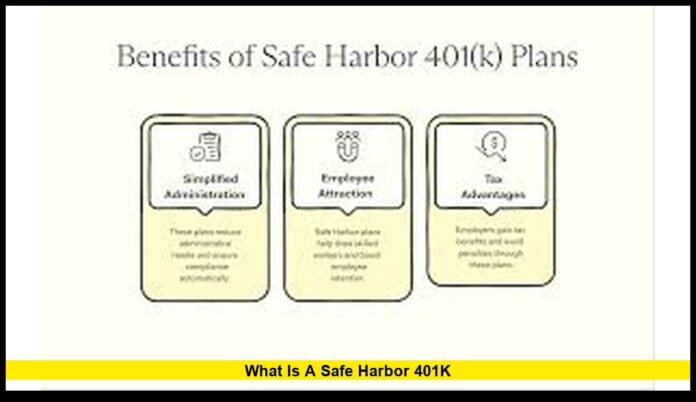Opening Paragraph
A safe harbor 401(k) is a retirement plan design that permits employers to make mandatory contributions and immediate vesting so the plan automatically meets many IRS nondiscrimination tests. As of 2025, employers who adopt this structure must follow specific deadlines, contribution rules, and notice requirements to qualify.
What Makes a Safe Harbor 401(k) Different?
A safe harbor 401(k) stands apart from a traditional 401(k) in several key ways:
- Employer contributions are fully vested immediately once made.
- The employer chooses a contribution method (matching or non-elective) that meets safe harbor rules.
- The plan is exempt from certain annual tests — such as the Actual Deferral Percentage (ADP) and Actual Contribution Percentage (ACP) tests — that traditional 401(k)s must undergo.
- The employer must provide a written notice to eligible employees about their rights and the safe harbor provisions each year.
Key Contribution Options for Employers
Employers using a safe harbor 401(k) typically select one of the following contribution formulas:
| Contribution Type | Typical Formula Example | Immediate Vesting? |
|---|---|---|
| Basic Matching | 100% match on the first 3% of pay + 50% match on next 2% of pay (i.e., up to 4%) | Yes |
| Enhanced Matching | For example, 100% match on first 4% of pay | Yes |
| Nonelective Contribution | Employer contributes a fixed % of pay (e.g., 3%) for all eligible employees even if they don’t contribute | Yes |
By adopting one of these, an employer ensures the safe harbor status is upheld.
2025 Updates & Contribution Limits
Here are several of the most current 2025 details for safe harbor 401(k) plans:
- The elective deferral limit for participants under age 50 is $23,500 (same as standard 401(k)).
- For participants age 50 or older, catch-up contributions apply (generally up to $7,500), though some special rules may permit higher limits for certain ages.
- A new safe harbor plan using the calendar year typically must be in effect by October 1, 2025 to count for the 2025 plan year for many employers.
- The employer notice to employees must be given at least 30 days and at most 90 days before the plan year begins.
- For existing plans that wish to add safe harbor matching for the next year, a deadline of December 1, 2025 often applies for notifying employees.
Why Employers Choose a Safe Harbor 401(k)
Advantages for employers:
- Simplified compliance: By meeting the safe harbor rules, the employer avoids the annual nondiscrimination tests that traditional 401(k) plans face.
- Enables higher contributions by highly-compensated employees (HCEs) without as much risk that the plan fails testing.
- Attracts and retains employees: The guarantee of immediate vesting and employer contributions is a strong benefit for workers.
Trade-offs to consider:
- Cost: The employer must commit to making the contributions (match or nonelective) every year.
- Less flexibility: Because contributions must vest immediately, the employer cannot use a vesting schedule (e.g., waiting several years) as a retention tool.
- Up-front setup: Timing and notice requirements must be followed precisely to maintain safe harbor status.
When Does a Safe Harbor 401(k) Make Sense?
A safe harbor 401(k) is suitable for companies that:
- Have many high-paid individuals and want to avoid failing nondiscrimination testing.
- Want to offer robust retirement benefits with immediate vesting to appeal to employees.
- Prefer to streamline plan administration and reduce the compliance burden associated with more complex 401(k) rules.
- Especially if non-highly compensated employees participate at lower rates, the safe harbor structure may avoid refunds or corrective contributions.
Conversely, if an employer has a very small workforce, uniform contribution behavior and low administrative complexity, a traditional 401(k) (with vesting schedules and voluntary employer contributions) might suffice.
Checklist for Employers Considering a Safe Harbor 401(k)
Before implementing, employers should ensure:
- A safe harbor contribution method (basic match, enhanced match, or nonelective) is selected and included in the plan document.
- The plan document specifies immediate vesting of employer safe harbor contributions.
- Employee notice is prepared and delivered in the required timeframe (typically 30-90 days before the plan year).
- Elective deferral process is set so employees may contribute by the required date (often by the plan year-start or by a specified deadline such as October 1 for new plans).
- Plan amendments (if converting from a traditional 401(k) to safe harbor) are made in accordance with deadlines.
- All employees eligible under the plan are informed and understand their rights, contribution options and the safe harbor features.
Closing Thoughts
For U.S. employers and employees alike, understanding what a safe harbor 401(k) plan means is increasingly important as retirement benefit expectations rise. These plans offer a path to immediate vesting employer contributions, simpler compliance for the employer, and attractive savings opportunities for employees — yet they require careful planning, timing and documentation. If your company is exploring retirement plan design, or if you’re an employee seeking to understand your benefits, this structure is well worth a closer look.
We welcome your questions or experiences regarding safe harbor 401(k) plans — feel free to comment below and stay tuned for future updates.
